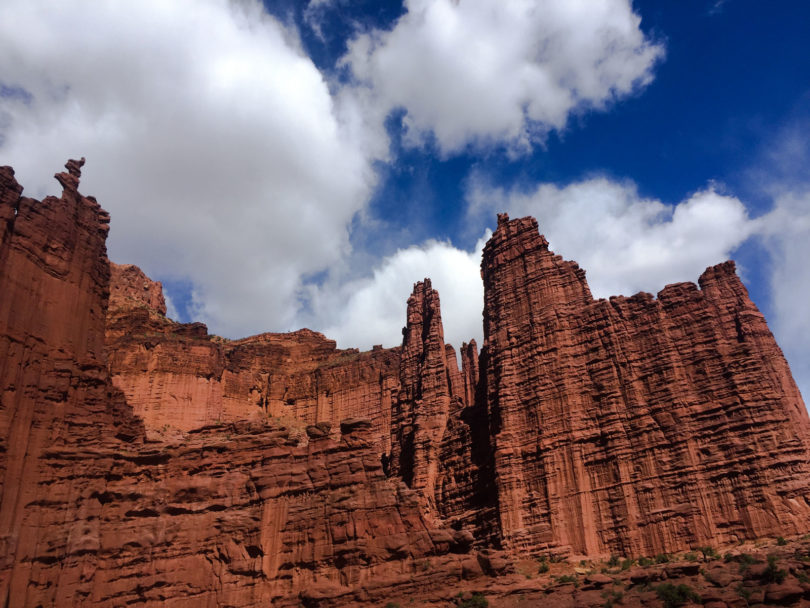Utah is famous for its adventures and its national parks, which are collectively known as the Mighty Five. But the whole state is ridiculously scenic. Moab, a city in eastern Utah, is a gateway to both Arches and Canyonlands National Parks. If you want to avoid the park crowds — and/or travel with your canine best friend — quieter, dog-friendly public lands abound.
The Sabuagana Utes long occupied this area of Utah along the Colorado River on the west side of the giant La Sal Mountains. White settlers tried unsuccessfully to gain control of the river crossing here, but they didn’t establish a permanent settlement until the late 1870s. Mormon farmers and ranchers moved in, followed by uranium miners, oilmen and a potash plant in the 20th century. Western filmmakers discovered Moab in the 1940s, and John Wayne spent some time here.
But it wasn’t until the early ’80s, when Moab was featured on the cover of Mountain Bike magazine, that the small city (which has a population of only about 5,000) became known as an adventure capital. Since then, people have come to Moab from all over the world to bike, hike, raft, base jump, skydive, rock climb and simply enjoy the striking red rock landscape.
Mountain Biking
The terrain around Moab is smooth, red-weathered sandstone called slickrock, so named because shod horses found it notoriously slippery. Turns out, that rock, which gets even slicker when wet, is heaven for mountain bikers. The more-than-900 miles of mountain bike trails around Moab are classified as green (easy), blue (intermediate) or black diamond (advanced), just like ski slopes. If you’re curious about mountain biking but are too cautious to just rent a bike and go for it, you’ll find plenty of guided rides and skills clinics in Moab. Newbies can join Rim Tours’ family-friendly, half-day Courthouse Loop tour as an intro to mountain biking.
Hiking
Moab also has many miles of hiking trails, both inside and outside of Arches and Canyonlands. If you brought your dog, you’ll want to stay outside of the pet-restrictive parks.
Scenic Highway 128 stretches out of Moab and is chock full of impressive hiking spots. The four-mile roundtrip Grandstaff Canyon Trail includes many stream crossings and ends at a natural arch. The trail is named for William Grandstaff, the first African American in the area, who ran cattle in this canyon in the late 1870s.
The Fisher Towers trail, also up Highway 128, boasts intricate red rock formations. Elevation changes over the five-mile, round-trip trail lead to tired legs. However, views of The Titan — said to be the largest, free-standing natural tower in the United States — and other notable rocks are worth it.
Visitors who want more thrills can contact one of the many canyoneering outfitters for an adventure that includes hiking, rappelling, scrambling, climbing and swimming.
Rafting
The Colorado River is a popular rafting destination. Visitors who like mild thrills can take a half-day guided rafting trip near Fisher Towers. Those who prefer a wetter and more intense experience can sign up for multi-day trips through Cataract Canyon in Canyonlands National Park. This option involves camping, cookouts and being flown out at journey’s end by a charter plane.
Side Trip to Bear’s Ears
Moab has plenty to keep you busy for a week or so. But if you like exploring Native American sites, a side trip to Bear’s Ears is worth the two-hour drive. This natural area in southeastern Utah is sacred to multiple Native American tribes and has a huge concentration of ruins, pictographs and petroglyphs. Bear’s Ears became a national monument at the end of President Obama’s administration and remains uncrowded. Take a short hike up to Ballroom Cave, a Native American dwelling set right into a cliffside, and you can almost imagine what it looked like in 1250.
What’s a trip without food?
Tourists can expect good food to complement all this outdoor adventure. Moab’s Eklecticafe has a beautiful garden and serves wraps, Indonesian satay and all-day breakfast. Sabaku Sushi’s menu includes unusual types of sake and a half-dozen inventive vegetarian rolls, including one with fried apples, mango and macadamia nuts. If you’re staying in a cabin with a kitchen and preparing your own meals, shop with the locals at Moonflower Community Cooperative.
If you go
Moab has a small airport with few flights. The most direct way to get there from Virginia is to fly from Norfolk or Richmond to Grand Junction, Colo., and rent a car for the 110-mile drive to Moab. It’s a beautiful drive through the Colorado Plateau.


